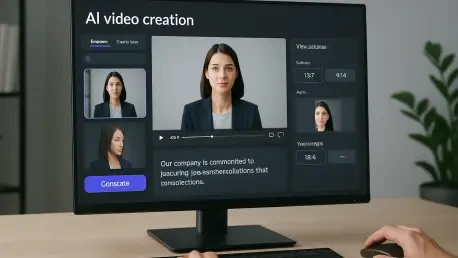In a world where digital content creation is evolving at an unprecedented pace, the emergence of cutting-edge tools can dramatically shift how creators and businesses approach video production, and a significant leap forward has come with the release of Wan 2.2, an open-source video generation model unveiled by Alibaba in late July. This innovative AI tool is not just an incremental update but a potential game-changer, promising to make high-quality video creation more accessible and efficient than ever before. Built on the foundation of its predecessor, Wan 2.1, this model introduces advanced features that could reshape industries ranging from entertainment to advertising. With its open-source framework and remarkable capabilities, the technology invites a broader community to contribute to and benefit from AI-driven video solutions, sparking curiosity about whether it can truly set a new standard in the field.
Breaking New Ground with Technology and Accessibility
Wan 2.2 stands out in the crowded AI landscape due to its groundbreaking Mixture-of-Experts (MoE) architecture, a novel approach for open-source video generation models. This design cleverly routes tasks to specialized sub-models, slashing computational demands by as much as 50% while still producing cinematic-quality visuals. The model can generate 720p videos using a single RTX 4090 GPU with just 22GB of VRAM, a feat that significantly lowers the entry barrier for high-end video production. This efficiency means that individual developers, small startups, and even hobbyists can now create professional-grade content without needing access to expensive, high-powered hardware. Beyond raw performance, the technology offers smooth transitions, realistic physics, and precise control over elements like lighting and camera angles, ensuring that the output rivals what was once only possible with dedicated studio setups. Such advancements signal a shift toward democratizing tools that were previously out of reach for many.
Another remarkable aspect of Wan 2.2 is its versatility and global appeal, tailored to meet diverse creative needs. The model comes in specialized variants, such as Wan2.2-T2V-A14B for text-to-video and Wan2.2-I2V-A14B for image-to-video tasks, with a combined parameter count of around 27 billion. This allows for intricate handling of complex motions and accurate replication of reference styles through data-driven training and first-last frame conditional control. Additionally, support for both English and Chinese prompts broadens its usability across different linguistic and cultural contexts, making it a tool with worldwide potential. Available under the Apache 2.0 license on platforms like GitHub and Hugging Face, it encourages rapid adoption and community-driven enhancements. This open accessibility fosters an environment where continuous improvement and innovation can thrive, potentially accelerating the pace of development in AI video technology.
Competing in a Global AI Arena
The release of Wan 2.2 has intensified competition in the AI video generation space, particularly challenging closed models from major players like OpenAI’s Sora. Unlike many proprietary systems, Wan 2.2’s open-source nature provides users with unparalleled access to its inner workings, allowing for customization and greater precision in cinematic styling. This transparency is a significant advantage for industries such as advertising and gaming, where tailored visual content is critical. Reports from tech communities on platforms like X and various publications have hailed it as possibly the leading AI video generator currently available, citing its multi-tasking capabilities across text-to-video, image-to-video, and video editing. Such feedback underscores the model’s potential to disrupt traditional workflows and offer creators tools that are both powerful and adaptable to specific needs.
Beyond individual use cases, Wan 2.2 reflects a broader strategic push by Alibaba to assert dominance in the global AI market. Backed by a reported $52 billion investment in AI initiatives, the integration of this model into Alibaba Cloud for enterprise applications highlights its scalability for larger, commercial purposes. This move not only positions the technology as a cornerstone for hybrid architectures and cloud services but also fosters a collaborative ecosystem where businesses can leverage AI for innovative solutions. However, with great power comes responsibility, and ethical concerns, particularly around the potential misuse for creating deepfakes, have surfaced. Industry observers are calling for robust safeguards to mitigate risks, emphasizing the need for balanced progress that prioritizes both innovation and accountability in the deployment of such transformative tools.
Shaping the Future through Open Innovation
Looking back, the introduction of Wan 2.2 marked a pivotal moment in how AI could transform video creation through open collaboration. Its ability to deliver high-quality output on consumer-grade hardware redefined accessibility, empowering a diverse range of creators to experiment and innovate. The model’s advanced features, coupled with an open-source framework, encouraged a community-driven approach that accelerated enhancements and adaptations across various sectors. Even as ethical challenges loomed, the groundwork laid by this technology inspired discussions on responsible AI development. Moving forward, the focus should shift to establishing comprehensive guidelines and tools to prevent misuse while continuing to harness the potential of open innovation. Exploring partnerships between tech companies, policymakers, and creative communities could ensure that future advancements build on this legacy, balancing creativity with caution to shape a more inclusive and ethical digital landscape.









